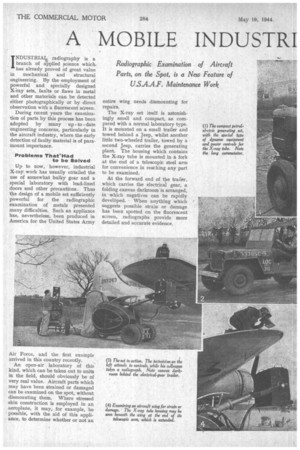A MOBILE INDUSTRI RADIOGRAPHY SET
Page 30

Page 31

If you've noticed an error in this article please click here to report it so we can fix it.
INDUSTRIAld radiography is a branch of applied science which. has already proved of great value in mechanical and structural engineering. By the employment of powerful and specially designed X-ray sets, faults or flaws in metal and other materials can be detected either photographically or by direct observation with a fluorescent screen.
During recent years the examination of parts by this process has been adopted by many up to date engineering concerns, particularly in the aircraft industry, where the early detection of faulty material is of paramount importance.
Problems That`Had to be Solved Up to now, however, industrial X-ray, work has usually entailed the use of somewhat bulky gear and a special laboratory with lead-lined doors and other precautions. Thus the design of a mobile set sufficiently powerful for the radiographic examination of metals presented many difficulties. Such an appliance has, nevertheless, been produced in America for the United States Army Air Force, and the first example arrived in this country recently.
An open-air laboratory of this kind, which can be taken out to units in the field, should obviously be of very real value. Aircraft parts which may have been strained or damaged can be examined on the spot, without dismounting them. Where stressed skin construction is employed in an aeroplane, it may, for example, be possible', with the aid of this appliance, to determine whether or not an entire wing needs dismounting for repairs.
The X-ray set itself is astonishingly small and compact, as compared with a normal laboratory type. It is mointed on a small trailer and towed behind a Jeep, whilst another little two-wheeled trailer, towed by a second Jeep, carries the generating plant. The housing which contains the X-ray tube is mounted in a fork at the end of a telescopic steel arm for convenience in reaching any part to be examined.
At the forward end of the trailer, which carries the electrical gear, a folding canvas darkroom is arranged, in • which negatives can be rapidly developed. When anything which suggests possible strain or damage has been spotted on the fluorescent screen, radiographs provide more detailed and accurate evidence. When taking radiographs or making direct observations the operator wears special clothing, including lead-lined gloves, a mask and a protective apron. Powerful rays of this kind may be highly dangerous.
Owing to the delicate nature of X-ray apparatus, and in particular the tubes, special suspension is provided for the tricycle trailer carrying this part of the unit. Large-diameter coil springs are used for the rear axle, and twin tyres are fitted. The generating set, with its petrol engine and dynamo, rides on a two-wheeled trailer with ordinary leaf springs.
Stressed castings are employed nowadays in aircraft construction to an extent undreamed of a few years ago, and here X-ray inspection does, undoubtedly, offer an important safeguard against the continued employment of material which, although to all outward appearances may seesxi sound, is, nevertheless, in a dangerous condition.
A team of two technicians and two drivers can operate this mobile openair laboratory. The technical men need to he thoroughly experienced in industrial radiography and the practical side of taking X-ray photographs, but they must also be metallurgists, for it is up to them to make the necessary diagnosis.
Other Spheres of Employment The great advantages attaching to the use of a mobile unit such as this in assisting aircraft maintenance are obvious, but the appliance suggests other fields of application and development. In structural engineering, for instance, where bringing the mountain to Mahomet may be out of the question, roof girders or steelbridge parts —light well be examined in place with a specially designed unit of this nature. Industrial radiography can have many useful applications when it is possible to transport the laboratory to the spot.
The use of two small trailers hauled by Jeeps is excellent for an air force in the field, but would be unnecessary for• civil-engineering purposes. A larger trailer with fully equipped darkroom and other aids to the photographic side of the work might be employed without difficulty when proper roads are available. The set we have described is designed for war, not for peace-time employment. The moral is obvious, as the scheme is equally applicable to bridges, buses or boats.




























































